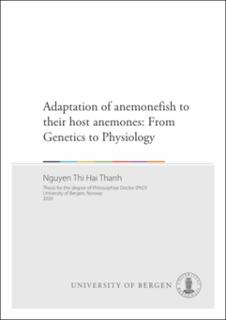Adaptation of anemonefish to their host anemones: From Genetics to Physiology
Doctoral thesis
Permanent lenke
http://hdl.handle.net/1956/21466Utgivelsesdato
2020-02-21Metadata
Vis full innførselSamlinger
Sammendrag
The mutualism between anemonefish and anemones can be studied in terms of permanent or temporary adaptation of fish toward their host anemones. This thesis explores this theme, and aims to test (1) Whether a mutual relationship leads to adaptation of anemonefish symbionts to their host anemones through coevolution (2) Whether Amphiprion ocellaris juveniles are able to acclimate to live with multi host anemone species (unnatural hosts), and what the consequences may be in terms of growth and activity, and (3) Whether the acclimation of fish is mediated by biochemical changes in skin mucus. These questions were explored using a cophylogenetic appoarch, and an experimental system based on Amphipron occelaris, a specialist anemone fish, and its response to manipulations of access to its natural host anemone. The phylogenetic analysis carried out in this thesis did not detect any evidence for historical coevolution between anemonefish and anemones. Although there was some dependence of the symbiont anemonefish on the host anemones, the genetic composition of one species (anemonefish) does not necessarily evolve alongside or in response to the other (anemones), despite the close association between the two species. The experimental approach provides new insight into the adaptation of Amphiprion ocellaris juveniles to recognize their host at the settlement stage, and their capacity and strategy to adapt to an unnatural host in the absence of their natural hosts, in captive conditions. Moving from natural to unnatural hosts affected the fitness of the juveniles, as measured by decreases in growth and changes in swimming activities. Changes in the protein profiles of the skin mucus were also informative; and provide a list of novel compounds in both naive fish and experienced fish living with different anemone hosts. The function of proteins based on gene ontology analysis can broadly be classified as belonging to immunologic defence, molecular transport, stress response, and signal transduction groups. These findings contribute to understanding the mechanism of anemone – anemonefish symbiosis, and also allow some speculation about the future of coral reefs under a changing environment, especially climate change. If climate change affects anemone species, some anemonefish species such as Amphiprion ocellaris might be able to seek alternative hosts but might experience reduced fitness.
Består av
Paper I: Nguyen, H-T.T, Dang TB, Glenner H., Geffen, AJ. (2020) Cophylogenetic analyses of the relationship between anemonefish Amphiprion (Perciformes:Pomacentridae) and their symbiotic host anemones (Anthozoa: Actiniaria). Mar Biol Res. 16(2):117–133. The article is not available in BORA due to publisher restrictions. The published version is available at: https://doi.org/10.1080/17451000.2020.1711952Paper II: Nguyen, H-T.T, Tran A-NT, Ha LTL, Ngo DN, Dang TB, Geffen, AJ. (2019) Host choice and fitness of anemonefish Amphiprion ocellaris (Perciformes: Pomacentridae) living with host anemones (Anthozoa: Actiniaria) in captive conditions. J Fish Biol. 94:937-947. The article is available in the main thesis. The article is also available at: https://doi.org/10.1111/jfb.13910
Paper III: Nguyen, H-T.T, Zhao M., Wang T., Dang TB, Geffen, AJ., Cummins S.F (2020). Sea anemone – anemonefish symbiosis: Behaviour and mucus protein profiling. The article is not available in BORA.

